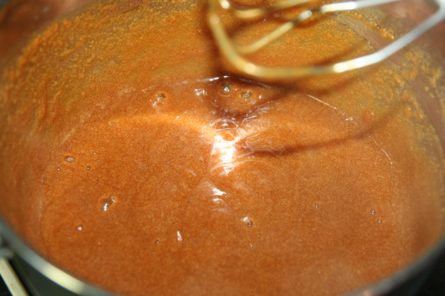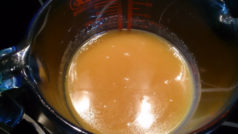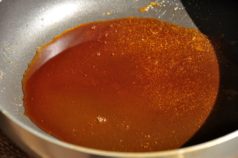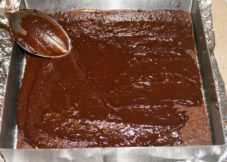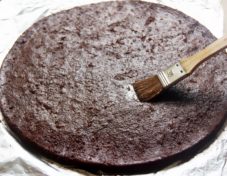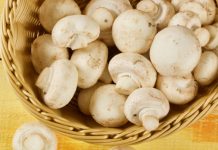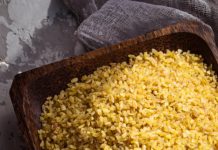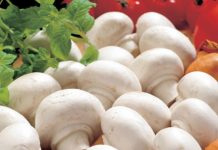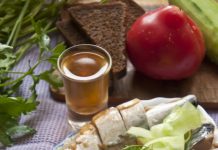In American pastry traditions it is customary to use thick biscuit cakes smeared with butter cream for cakes. For our sweet tooth, this is absolutely unacceptable, so we often use cake impregnation, which gives the dessert a juiciness and tenderness.
Material Content:
Sugar impregnation for biscuit cake
In fairness, it should be noted that not all types of biscuits need to be impregnated. Humid enough are Red Velvet, Hummingbird, Chiffon Sponge Cake, Dark Larry, but you can’t make a delicious cake from a classic biscuit without moisturizing.
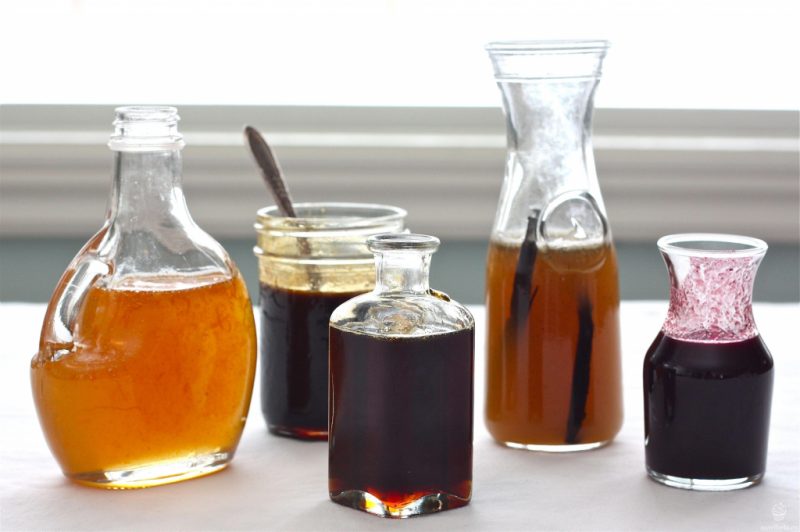
So, sugar type of impregnation is the most popular and the most inexpensive. It is easy to prepare, and only water, sugar and alcohol (cognac, rum, port or liquor) are part of the syrup.
Since cakes of different diameters and, consequently, weights will require different amounts of liquid for soaking, it is convenient to use proportions per 100 g of ready-made sugar syrup, in which a tablespoon acts as a measure of weight and volume.
Thus, the indicated amount of sugar impregnation will require:
- 3 tablespoons of water;
- 2 tablespoons of granulated sugar;
- ½ tablespoon brandy.
Cooking steps:
- Put sugar and water in a thick-bottomed vessel on medium heat and bring to a boil with continuous stirring. So that the resulting syrup does not have to be impregnated, interfering, you need to make sure that sugar crystals do not get on the walls.
- A boiled solution can be removed immediately from the stove, or you can let it gurgle for several minutes, cool slightly and add alcohol.
To correctly calculate the amount of impregnation and cream for the future cake, the following formula will be useful for the housewives - 1: 0.7: 1.2, where one part is the weight of the biscuit, 0.7 is the amount of impregnation and 1.2 is the weight of the cream.
With berries and cognac
Syrup for cake soaking can be made with the addition of a berry composition. Depending on the chosen base, the finished dessert will have its own unique relish. So, the taste of cherries goes well with chocolate biscuit.
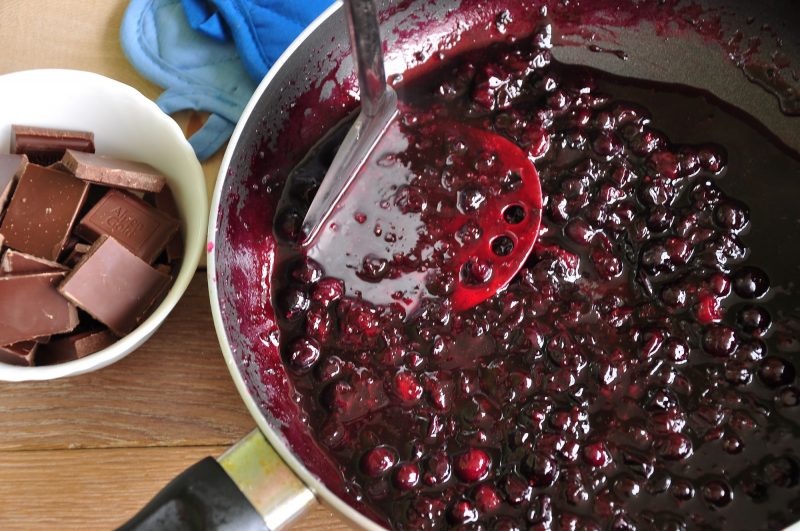
To prepare cherry impregnation with cognac, it is necessary to prepare:
- 75 g of fresh seedless cherry berries;
- 220 ml of water;
- 55 g of sugar;
- 30 ml of brandy.
Working process:
- To put in the stewpan the washed berries without tails and pits, pour them with water and bring to a boil. Boil for two or three minutes and allow to cool at room temperature to 30 - 35 degrees.
- Catch all the berries from a warm broth (if they are small, you can simply strain through a sieve), pour in sugar, pour in cognac and stir. As soon as the last sweet crystal dissolves - the impregnation is ready.
With caramelized condensed milk flavor
Boiled condensed milk has a pleasant caramel taste, but it cannot be used in its pure form for impregnating cakes, since this product is too thick.
Therefore, it will have to be slightly diluted with milk in the following ratio:
- 150 g of boiled condensed milk;
- 150 g of milk;
- 15 ml of brandy.
Cooking method:
- Put the refractory container with milk on the fire and warm it up a bit, then put the boiled condensed milk and mix thoroughly until it is completely melted.
- After that, cool the milk-caramel impregnation and mix with cognac. The result is a coffee-colored solution with a pleasant tart taste.
Coffee impregnation for milk cake
Coffee lovers will love juicy biscuits soaked in a sweet coffee solution with the addition of milk. The specific aroma perfectly complements and shades the taste of chocolate cakes.
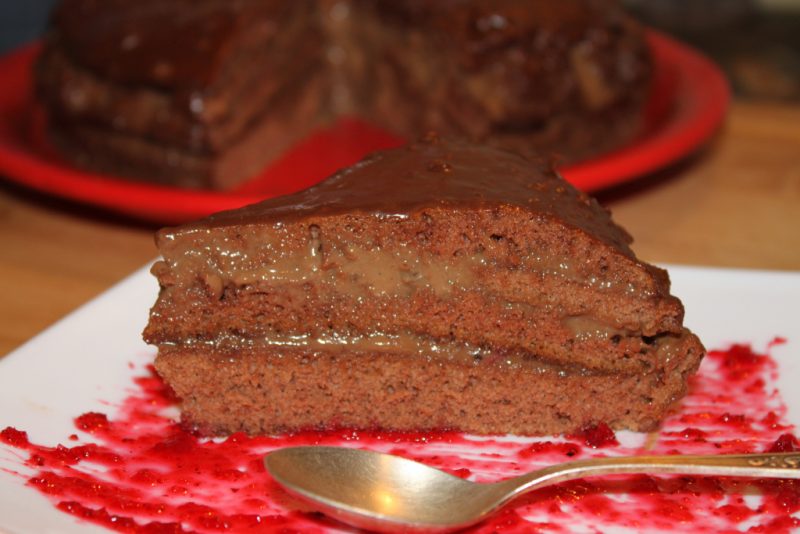
To prepare such an impregnation, you will need:
- 36 g of natural ground coffee;
- 180 g of granulated sugar;
- 125 ml of water;
- 125 mo of milk;
- 15 - 20 ml of brandy or coffee liquor.
The sequence of actions:
- Combine milk with sugar and heat over a fire until sweet grains of sand are completely dissolved.
- In the indicated amount of milliliters of water, make coffee. After boiling the Turku with a fragrant drink, set aside for 15 to 20 minutes to insist.
- Strain the finished coffee, mix with sweet milk and liquor.
Cooking from Lemon Juice
Lemon impregnation is suitable for Queen Victoria's classic, vanilla or biscuit. In the hot season, you should definitely add a little alcohol to it, which will act as a preservative and help keep the dessert fresh for longer.
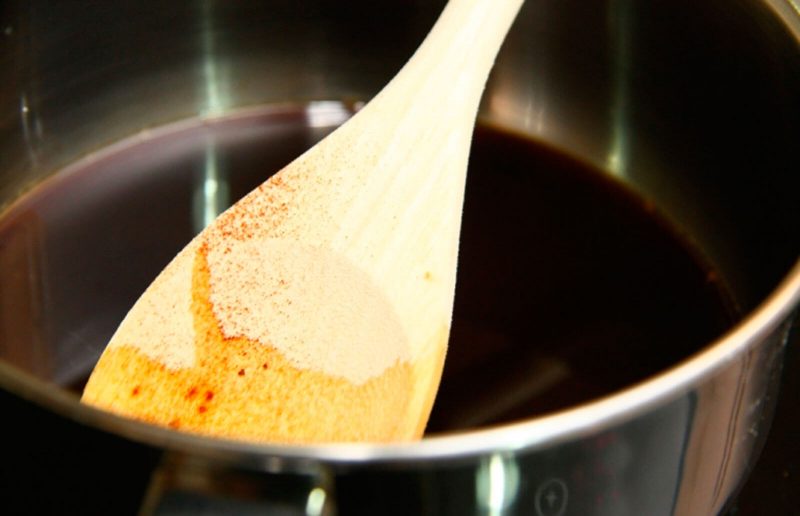
If there is concern that the mixture for soaking the cakes will be too acidic, you can take other citrus fruits (for example, orange or lime).
Proportions of products in the composition of the syrup:
- 250 ml of water;
- 90 g of sugar;
- ½ lemon (juice and zest);
- 30 ml of brandy.
How to make sugar syrup to soak the cake on lemon juice:
- In a small saucepan or saucepan, combine water with sugar. Send the sweet solution to the fire and bring to a boil.
- While the syrup is boiling, subtly remove the zest from the lemon and survive the juice. Sugar with water should be drilled for 4 - 5 minutes, then you need to remove the stewpan from the stove, add juice and zest to its contents, cover the composition with a lid and leave to cool completely.
- Strain the cooled impregnation, add cognac, mix and use for its intended purpose.
Not only should the impregnation of the cakes be cooled, but they themselves should not be hot. It is good that they generally lie down in the refrigerator wrapped in cling film for at least several hours.
Honey based
You can replace the usual sugar in the composition of the impregnation with honey. Not only connoisseurs of this beekeeping product know that one or another of its varieties (flower, buckwheat, forbs, acacia) can differ significantly in taste and make the taste of baking unique.

So that such a syrup does not turn out to be too cloying, it is recommended to introduce into it a little orange or lemon juice, which will balance the excessive sweetness.
The composition of one portion of such a solution includes:
- 150 ml of water;
- 40 - 50 g of honey;
- ½ orange;
- 30 ml of brandy.
Cooking:
- Squeeze juice from half of the citrus fruit in any way possible. Combining it with water, bring to a boil, and then allow to cool to a temperature below 60 degrees. Only at this temperature regime, all the beneficial substances that honey is rich in are preserved.
- Add honey and cognac to the slightly cooled base, mix everything until smooth and you can begin to impregnate biscuits.
Honey impregnation will be an ideal complement for light cakes, layered with sour cream.
Milk impregnation for cake
A popular milk treatment can be prepared in two different ways: from whole cow's milk and sugar, or from water and condensed milk. Which one to choose, only their own taste preferences will be able to tell, and the proportions and algorithm for preparing each of the species will be given below.
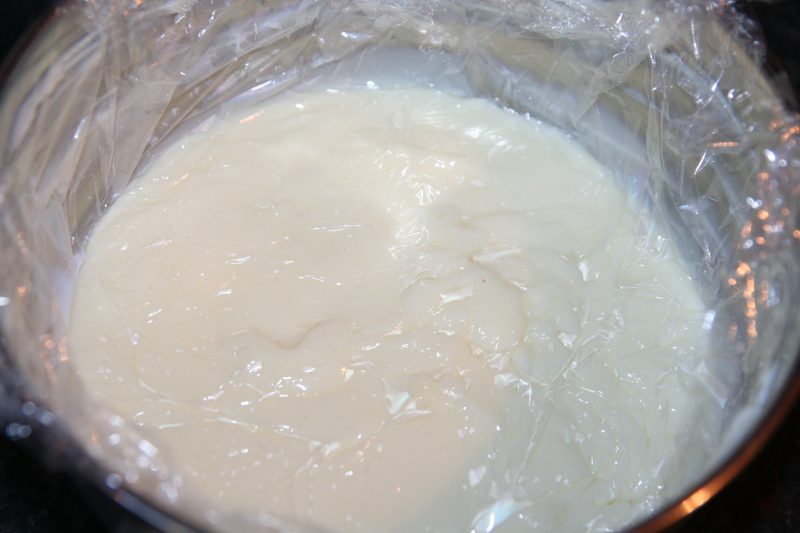
For the first version of the syrup you will need:
- 200 ml of milk of any fat content;
- 60 g of granulated sugar.
Cooking:
- Combine milk with sugar and boil for about two minutes.
- Then cool the milk mixture to room temperature, and it is ready.
The composition of milk impregnation with condensed milk includes:
- 200 ml of condensed milk;
- 225 ml of water;
- vanilla to taste.
Cooking Technology:
- On the stove, bring the water to a boil, the liquid should actively gurgle.
- Put condensed milk into a container of a suitable displacement, pour it on top with a steep mixture, add vanilla and mix.
- With cooled syrup, you can soak cakes.
Read also:biscuit impregnation
Chocolate syrup for soaking cakes
Such impregnation of cakes is the dream of a real chocolatier. She will not only make the biscuit juicy, but also greatly enhance its chocolate taste.
Such a syrup is prepared from:
- 120 ml of water;
- 30 ml of brandy or other alcohol;
- 150 g of sugar (it is better to take brown);
- 35 g of cocoa powder;
- 1 - 2 g of vanillin;
- 3 g of salt.
How to cook chocolate soak:
- Pour cocoa powder into the stewpan. Then gradually pouring water, stir so that there are no lumps. Then, with constant stirring, warm the mixture until the components are completely melted.
- After that pour sugar, stir it, add salt and vanillin.
- Boil the syrup for about three minutes after boiling.
- Like other syrups, chocolate is used after cooling.
Of great importance for the juiciness of the finished cake is the method of impregnation. In order for the cakes to be saturated with the syrup evenly, it does not need to be applied with a spoon, the best result will be achieved if you use a culinary brush or spray.


